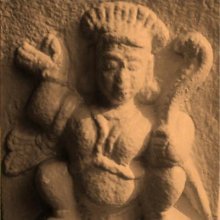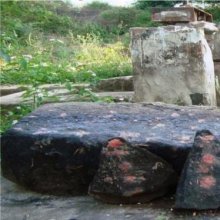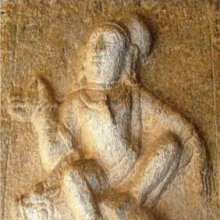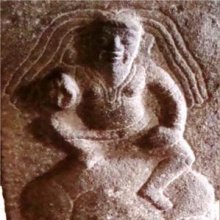Chinmudra, Chin-mudra, Chinmudrā: 4 definitions
Introduction:
Chinmudra means something in Hinduism, Sanskrit. If you want to know the exact meaning, history, etymology or English translation of this term then check out the descriptions on this page. Add your comment or reference to a book if you want to contribute to this summary article.
Alternative spellings of this word include Chhinmudra.
Images (photo gallery)
In Hinduism
Yoga (school of philosophy)
Source: Typepad: Mudras for PranayamaChin Mudra (psychic gesture of consciousness) This mudra is used in either seated meditation or pranayama such as ujjayi. The hands rest on knees or thighs facing down. This Gesture has a grounding effect on the mind.The middle finger, ring, and little finger represent the three classic qualities of all of nature (the Three Gunas). The middle finger symbolizes sattva, (purity, wisdom and true understanding) the ring finger rajas, (action, passion and movement) and the little finger tamas, (inertia, lethargy and darkness). Classically the yogi is meant to transcend these states, progressing from darkness into light and from ignorance to wisdom.

Yoga is originally considered a branch of Hindu philosophy (astika), but both ancient and modern Yoga combine the physical, mental and spiritual. Yoga teaches various physical techniques also known as āsanas (postures), used for various purposes (eg., meditation, contemplation, relaxation).
Pancaratra (worship of Nārāyaṇa)
Source: SriMatham: Vaiṣṇava Iconology based on Pañcarātra ĀgamaChin Mudra (“The Gesture of Teaching”):—This mudra indicates that God is the Supreme Guru and repeatedly takes birth in order to teach us the Dharma. In the Incarnation of Krishna he taught the Bhagavad Gita.

Pancaratra (पाञ्चरात्र, pāñcarātra) represents a tradition of Hinduism where Narayana is revered and worshipped. Closeley related to Vaishnavism, the Pancaratra literature includes various Agamas and tantras incorporating many Vaishnava philosophies.
Shilpashastra (iconography)
Source: Google Books: Elements of Hindu iconographyIn the Chinmudrā (छिन्मुद्रा), the tips of the thumb and the forefinger are made to touch each other, so as to form a circle, the other fingers being kept open. The palm of the hand is made to face the front. This is the mudrā adopted when an explanation or exposition is being give; hence it is also called vyākhyānamudrā and sandarśanamudrā.

Shilpashastra (शिल्पशास्त्र, śilpaśāstra) represents the ancient Indian science (shastra) of creative arts (shilpa) such as sculpture, iconography and painting. Closely related to Vastushastra (architecture), they often share the same literature.
General definition (in Hinduism)
Source: Srimatham: Hindu IconologyChin Mudra — the gesture of teaching — palm displayed, fingers upwards thumb and fore-finger joined at the tips. This indicates the imparting of knowledge, form the deity to the contemplator and having received the knowledge the aspirant is expected to pass it on to others. The thumb pressing on the index finger indicates suppression of egoism, the 3 upraised fingers indicate overcoming self-referent desire, anger and greed.
See also (Relevant definitions)
Partial matches: Mudra, Chin, Cin.
Query error!
Full-text: Vyakhyanamudra, Sandarshanamudra, Dhyanamudra, Desika.
Relevant text
Search found 7 books and stories containing Chinmudra, Chin-mudra, Chin-mudrā, Chinmudrā; (plurals include: Chinmudras, mudras, mudrās, Chinmudrās). You can also click to the full overview containing English textual excerpts. Below are direct links for the most relevant articles:
Temples of Munnur (Historical Study) (by R. Muthuraman)
Images of Daksinamurti < [Chapter 5]
World Journal of Pharmaceutical Research
Mudras unlocking the healing potential for body and mind < [2023: Volume 12, August issue 13]
Diaspora of Bhuta (Daiva) worshipping cult—India and Indonesia (by Shilpa V. Sonawane)
Part 1.10 - Dhumavati—Das Mahavidya and form of Adi Parashakti < [Chapter 4 - Inter-Disciplinary Analysis]
Later Chola Temples (by S. R. Balasubrahmanyam)
Temples in Melakkadambur < [Chapter II - Temples of Kulottunga I’s Time]
Middle Chola Temples (by S. R. Balasubrahmanyam)
Temples in Attur < [Chapter II - Temples of Rajaraja I’s Time]
Temples in Tiruvorriyur < [Chapter IV - Temples of Rajendra I’s Time]



